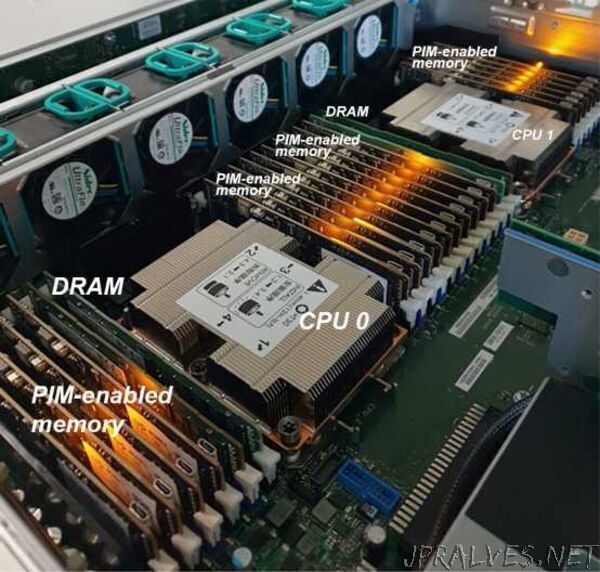
“Big Data applications require high computing performance while consuming as little power as possible. Current computer systems are reaching their limits in both areas. Professor Onur Mutlu is working on alternative systems and has just received the Intel 2021 Outstanding Researcher Award for his work.
You may have heard that Moore’s law is coming to an end. This empirical observation states that computers double their performance approximately every 2 years. Alternative approaches to improve the efficiency of computing are therefore in great demand. Prof. Onur Mutlu, whose research interests include hardware/software co-design at ETH Zurich, is pursuing the approach of combining computing and memory. Processing-in-memory (PIM) computing makes Big Data applications such as genome analysis both substantially faster and more energy-efficient.
Recently, the Grenoble-based company UPMEM launched the first commercially available PIM architecture. Instead of a processor or CPUs (Central Processing Units), it contains DPUs (DRAM Processing Units), which are memory elements that also process the data. Mutlu and his research group have characterised, analysed, and tested the new system and compared it with a previous state-of-the-art system with CPUs. They have learned that the novel system makes computing up to 23 times faster and five times more energy efficient. The new system is most interesting for data-intensive applications - specific examples include gene analysis or weather forecast models. “Not bad for the first commercial version of a processing-in-memory system,” Mutlu says, “compared to a processor-centric CPU system that has been optimised for decades.”
Mutlu and his colleagues have tested the novel system for applications in the fields of data analysis, databases, bioinformatics, image- and video analysis, and neural networks, among others. The PIM-system is best suited for workloads requiring little communication between DPUs (e.g. database and image applications) and primarily simple arithmetic operations (e.g. video analytics or data filtering). “We expect that as these systems evolve, they will become even faster and more energy efficient, and their applications will become even more diverse,” Mutlu reckons.
What kind of companies could use this new computing system? “Energy efficiency and sustainability should be key goals for any industry”, Mutlu believes. “But companies that already have an idea of how they will use the new PIM hardware will benefit immediately”, he says. “If their workloads are a good fit for the new architecture, performance and energy efficiency will improve greatly.”
Wide potential applications
Data centres could use the PIM system already. “Every software company should also consider it in order to be prepared for the future,” Mutlu says. Also, PIM is a substrate that makes embedded systems such as AR/VR glasses, drones, self-driving cars and others much more efficient. “Companies operating in these areas should think about how they could benefit from PIM in their systems.”
Mutlu is collaborating with several hardware and software companies, including Intel. Intel launched the Outstanding Researcher Awards for researchers who innovate and collaborate with Intel to advance the field of computing. Mutlu is one of the 2021 winners – along with 16 colleagues from around the world.
PIM systems enable a fundamentally more efficient approach to computing, unlike current standard systems where the processor made up of CPUs takes centre stage and the memory units are located far away from it. In such systems, the movement of data between the processor and memory nowadays limits the speed and efficiency of data processing, even though the processor itself is very powerful. And moving data requires the most energy - much more energy than the actual computation. “Accessing main memory just once consumes one hundred to a thousand times more energy than a complex addition,” Mutlu says.
Active collaborations with industry
Mutlu could imagine collaborating with further companies or software developers on projects such as testing and developing applications using the UPMEM PIM system and other prototype PIM systems. He is interested in working with companies who want to make their computation fundamentally efficient and thereby save a lot of energy.
“The PIM paradigm also has very favourable characteristics in terms of security”, Mutlu adds. A project that explores the security benefits of PIM could also be exciting for companies who care about the security of their data.”
